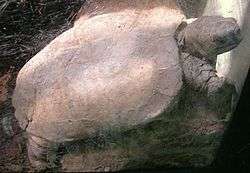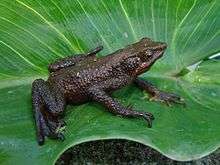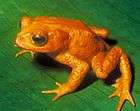Lazarus taxon

In paleontology, a Lazarus taxon (plural taxa) is a taxon that disappears for one or more periods from the fossil record, only to appear again later. Likewise in conservation biology and ecology, it can refer to species or populations that were thought to be extinct, and are rediscovered.[1] The term refers to the story in the Christian biblical Gospel of John, in which Jesus Christ raised Lazarus from the dead.
Potential explanations
Lazarus taxa are observational artifacts that appear to occur either because of (local) extinction, later resupplied, or as a sampling artifact. The fossil record is inherently sporadic (only a very small fraction of organisms become fossilized, and an even smaller fraction discovered before destruction) and contains gaps not necessarily caused by extinction, particularly when the number of individuals in a taxon is very low.
After mass extinctions, such as the Permian–Triassic extinction event, the Lazarus effect occurred for many taxa. However, there appears to be no link with the abundance of fossiliferous sites and the proportion of Lazarus taxa, and no missing taxa have been found in potential refuges. Therefore, reappearance of Lazarus taxa probably reflects the rebound after a period of extreme rarity during the aftermath of such extinctions.[2]
Related but distinct concepts
An Elvis taxon is a look-alike that has supplanted an extinct taxon.
A zombie taxon is a taxon that contains specimens that have been collected from strata younger than the extinction of the taxon. Later such fossils turn out to be freed from the original seam and refossilized in a younger sediment. For example, a trilobite that gets eroded out of its Cambrian-aged limestone matrix, and reworked into Miocene-aged siltstone.
A living fossil is an extant taxon that appears to have changed so little compared with fossil remains, that it is considered identical. Living fossils may occur regularly in the fossil record, such as the lampshell Lingula, though the living species in this genus are not identical to fossil brachiopods.[3]
Other living fossils however are also Lazarus taxa if these have been missing from the fossil record for substantial periods of time, such as applies for coelacanths.
Finally, the term "Lazarus species" is applied to organisms that have been rediscovered as being still alive after having been widely considered extinct for years, without ever having appeared in the fossil record. In this last case, the term Lazarus taxon is applied in neontology.
Animals that are Lazarus taxa are often cited by cryptozoologists as former cryptids.[4][5]
Reappearing fossil taxa

- Chacoan peccary (Catagonus wagneri), known only from fossils before its discovery in 1975.[6]
- Coelacanth (Latimeria), a member of a subclass (Actinistia) thought to have gone extinct 66 million years ago; live specimens found in 1938.
- Nightcap oak (Eidothea hardeniana and E. zoexylocarya), representing a genus previously known only from fossils 15 to 20 million years old, were recognized in 1995 and 2000, respectively.
- Gracilidris, a genus of dolichoderine ants thought to have gone extinct 15-20 million years ago was found in Paraguay, Brazil, and Argentina and described in 2006.
- Laotian rock rat (Laonastes aenigmamus), a member of a family (Diatomyidae) thought to have gone extinct 11 million years ago; found in 1996.[7]
- Majorcan midwife toad (Alytes muletensis), described from fossil remains in 1977, living animals discovered in 1979.
- Dawn redwood (Metasequoia), a genus of conifer, was first described as a fossil from the Mesozoic Era by Shigeru Miki in 1941, but in 1944 a small stand was discovered in China in Modaoxi by Zhan Wang.
- Monito del monte (Dromiciops), a member of a clade (Microbiotheria) thought to have gone extinct 11 million years ago.

- Monoplacophora, a class of molluscs believed to have gone extinct in the middle Devonian Period (c. 380 million years ago) until living members were discovered in deep water off Costa Rica in 1952.
- Mountain pygmy possum (Burramys parvus), Australia's only truly hibernating marsupial, known originally from the fossil record and then discovered in 1966.
- Schinderhannes bartelsi, a Devonian member of Anomalocarididae, a family previously known only from Cambrian fossils, 100 million years earlier.
- Wollemi pine (Wollemia), a species previously known only from fossils from 2 to 90 million years old representing a new genus of Araucariaceae, was discovered in 1994.
Reappearing IUCN red list species
Plants
.jpg)
- Afrothismia pachyantha
- Antirhea tomentosa
- Asplundia clementinae
- Badula platyphylla
- Blunt chaff flower (Achyranthes mutica)
- Bulbophyllum filiforme
- Bulbostylis neglecta
- Café marron (Ramosmania rodriguesii), thought extinct in the 1950s but rediscovered in 1980.
- Camellia piquetiana, long known only from the 19th century herbarium specimens labeled as Thea piquetiana until it was rediscovered in Vietnam in 2003.
- Climbing alsinidendron (Alsinidendron viscosum)
- Cyanea dunbariae
- Cyanea procera
- Pygmy Goosefoot (Dysphania pusilla), thought extinct since 1959, but rediscovered in 2015 in New Zealand.
- Eugenia bojeri
- Franciscan manzanita (Arctostaphylos hookeri), thought to be extinct in the wild since 1942, rediscovered in 2009.
- Furbish's lousewort (Pedicularis furbishiae), Canadian species identified as an extinct species in 1880, rediscovered in the 1970s.
- Jellyfish tree (Medusagyne oppositifolia)
- Mammillaria schwarzii
- Medemia argun
- Mount Diablo buckwheat (Eriogonom truncatum), thought extinct around 1935 but found again in 2005.
- Pittosporum tanianum
- Rhaphidospora cavernarum, thought to be extinct since 1873 but relocated during a survey of the Cape York Peninsula in 2008.
- She cabbage tree (Lachanodes arborea)
- Sicilian fir (Abies nebrodensis)
- Takhtajania perrieri
- Turbinicarpus gielsdorfianus
- Virginia round-leaf birch (Betula uber)
Cultivars
Protostomes
- Discus guerinianus, a Madeiran land snail thought extinct in 1996 but found again in 1999.
- Giant Palouse earthworm (Driloleirus americanus); thought extinct in the 1980s, but found again in 2006.
- Canterbury knobbed weevil (Hadramphus tuberculatus), last seen in 1922 until it was rediscovered near Lake Tekapo in December 2004.
- Lord Howe Island stick insect (Dryococelus australis); thought to be extinct by 1930 — rediscovered in 2001.
- Dinosaur ant (Nothomyrmecia macrops), Australian ant discovered in 1931, not seen again until 1977.
- Pitt Island longhorn beetle (Xylotoles costatus), New Zealand longhorn beetle, considered extinct from 1986 to 1996, found again on Chatham Islands.[8]
- Bone skipper fly (Thyreophora cynophila), first described (1794) and last seen in Central Europe (1850), before being photographed in Spain in 2009.[9]
Insecta
- Petasida ephippigera, a species of grasshopper thought to be extinct from 1900 until 1971, when a single male specimen was spotted, followed by a breeding pair shortly afterwards.
Fish
- Black kokanee (Oncorhynchus nerka kawamurae) Believed extinct in 1940, rediscovered in 2010
- Smoothtooth Blacktip Shark (Carcharhinus leiodon), known only from a specimen caught in 1902, the shark was rediscovered at a fish market in 2008.
Amphibians
- Armoured frog (Litoria lorica)
- Ansonia latidisca (Sambas Stream Toad) (Borneo Rainbow Toad)
- Painted frog (Atelopus ebenoides marinkellei), believed extinct 1995, rediscovered in 2006.
- Atelopus laetissimus
- Atelopus nahumae
- Hula painted frog (Discoglossus nigriventer)
- Isthmohyla rivularis
- Ixalotriton niger
- Large-crested toad (Bufo cristatus)
- Northern tinker frog (Taudactylus rheophilus)
- Philautus chalazodes
- Sumatra toad (Bufo sumatranus)
- Telmatobufo venustus, not seen from 1899 until 1999.
- Thorius minutissimus
Mammals
- Bavarian pine vole (Microtus bavaricus), believed extinct in the 1960s, but rediscovered in 2000.
- Brazilian arboreal mouse (Rhagomys rufescens)
- Bridled nail-tail wallaby (Onychogalea fraenata), thought to be extinct since the last confirmed sighting in 1937, but rediscovered by a fencing contractor on his property in rural Queensland in 1973.
- Caspian horse, thought to be descended from Mesopotamian horses which became extinct in the 7th century, but was rediscovered in the 1960s.
- Central rock rat (Zyzomys pedunculatus)
- Cuban solenodon (Atopogale cubanus), thought to have been extinct until a live specimen was found in 2003.
- Fernandina rice rat (Nesoryzomys fernandinae), thought extinct in 1996 (last seen 1980) but found again in the late 1990s.
- Gilbert's potoroo (Potorous gilbertii), extremely rare Australian mammal presumed extinct from the 19th century until 1994.
- Miller's grizzled langur (Presbytis hosei canicrus), presumed extinct 2010, rediscovered 2012.
- Leadbeater's possum (Gymnobelideus leadbeateri), thought to be extinct until 1965
- Mahogany glider (Petaurus gracilis), described in 1883 and not recorded between 1886 and 1973. An expedition by the Queensland Museum in 1989 found a living population.
- New Guinea big-eared bat (Pharotis imogene), previously, the species was believed to have been extinct since 1890, when it was last spotted. In 2012, researchers realised that a female bat collected near Kamali was a member of this species.[10]
- New Holland mouse (Pseudomys novaehollandiae), described by George Waterhouse in 1843, it was re-discovered in Ku-ring-gai Chase National Park, North of Sydney, in 1967.
- Philippine naked-backed fruit bat (Dobsonia chapmani), in 1996 the species was declared extinct by the IUCN, as none had been sighted since 1964, but the bat was rediscovered in 2000.
- Roosevelt's muntjac (Muntiacus rooseveltorum), it was re-discovered in Xuan Lien Nature Reserve in Vietnam's Thanh Hoa province in 2014.
- Santiago Galápagos mouse (Nesoryzomys swarthi ), thought extinct and last recorded in 1906, but was rediscovered in 1997.
- Tammar wallaby (Macropus eugenii), this Australian subspecies was presumed extinct from 1925 until genetically matched with imported species in New Zealand in 1998.
- Woolly flying squirrel (Eupetaurus cinereus), known only from pelts collected in Pakistan in the late 19th century, until live specimens were collected in the 1990s.
- Wimmer's Shrew (Crocidura wimmeri), believed extinct since 1976, but rediscovered in 2012 in Côte d'Ivoire.
- Yellow-tailed woolly monkey (Lagothrix flavicauda)
- Short-footed Luzon tree rat (Carpomys melanurus), believed extinct since 1896, but rediscovered in 2008 on Mount Pulag in northern Luzon.
- Machu Picchu arboreal chinchilla rat (Cuscomys oblativus), believed extinct since the 1400s or 1500s, but rediscovered in 2009 near Machu Picchu in Peru.
Reptiles

- Arakan forest turtle (Heosemys depressa), last seen in 1908 but found again in 1994.
- El Hierro giant lizard (Gallotia simonyi), rediscovered in 1974
- Gray's monitor (Varanus olivaceus), described in 1845, and not seen again by scientists for 130 years
- La Gomera giant lizard (Gallotia bravoana), rediscovered in 1999
- La Palma giant lizard (Gallotia auaritae), thought to have been extinct since 1500, but rediscovered in 2007.
- New Caledonian crested gecko (Correlophus ciliatus) rediscovered in 1994.[11]
- Short-nosed sea snake (Aipysurus apraefrontalis), rediscovered in 2015, after parting with their original habitat of the Ashmore and Cartier Islands for unknown reasons.
- Terror skink (Phoboscincus bocourti), a 50-cm-long lizard, was previously known from a single specimen captured around 1870 and was long presumed extinct. In 2003, on a tiny islet, it was rediscovered.
Birds
- Bahia tapaculo (Eleoscytalopus psychopompus)
- Banggai crow (Corvus unicolor), not recorded since 1884/1885, confirmed with a photograph in 2008.
- Beck's petrel (Pseudobulweria beckii), not seen between 1929 and 2007.
- Berlepsch's parotia (Parotia berlepschi)
- Bermuda petrel or "cahow" (Pterodroma cahow), thought extinct since 1620 until 18 nesting pairs were found in 1951 on an uninhabited rock outcropping in Bermuda. Bermudian David B. Wingate has devoted his life to bringing the birds back, and in the 2011-12 breeding season they passed 100-pair.[12][13]
 Bermuda petrel.
Bermuda petrel. - Grand Comoro scops-owl (Otus pauliani)
- Bruijn's brush-turkey (Aepypodius bruijnii)
- Cebu flowerpecker (Dicaeum quadricolor)
- Cone-billed tanager (Conothraupis mesoleuca), undetected from 1938 to 2003, but rediscovered in gallery forest in Emas National Park.
- Cuban kite (Chondrohierax wilsonii), confirmed with a photograph in 2009.
- Edwards's pheasant (Lophura edwardii), a Vietnamese pheasant presumed extinct from 1928 until it was rediscovered in 1998.
- Fiji petrel (Pseudobulweria macgillivrayi), first rediscovered on land in 1983, and at sea in 2009.
- Forest owlet (Heteroglaux blewitti), assumed extinct in the 19th century, but rediscovered in central India in 1997.
- Golden-fronted bowerbird (Amblyornis flavifrons)
- Ivory-billed woodpecker (Campephilus principalis), the "Lord God Bird," thought extinct circa 1987 before unconfirmed sightings in 1999, 2004, and 2006 in Arkansas and Florida.[14]
- Jerdon's courser (Rhinoptilus bitorquatus), a wader from India, assumed extinct until 1986.
- Kaempfer's woodpecker (Celeus obrieni), a Brazilian woodpecker feared extinct after no specimen had been found since its discovery in 1926. Rediscovered in 2006.
- Large-billed reed-warbler (Acrocephalus orinus), a warbler rediscovered in Thailand in 2006, previous known only from a specimen collected in India in 1867.
- Long-legged warbler (Trichocichla rufa)
- Madagascan serpent eagle (Eutriorchis astur), rediscovered in 1993, sixty years since the previous sighting.
- Madagascar pochard (Aythya innotata), thought extinct since 1991 until a small group were spotted in 2006.
- Myanmar Jerdon's babbler (Chrysomma altirostre altirostre), last seen in 1941, rediscovered in 2015.
- New Zealand storm-petrel (Oceanites maorianus), believed extinct from 1850 but sighted again in 2003.
- Night parrot (Pezoporus occidentalis), extremely rare Australian bird presumed extinct from the 1880s until 1990.
- Noisy scrub-bird (Atrichornis clamosus)
- São Tomé fiscal (Lanius newtoni)
- São Tomé grosbeak (Neospiza concolor)
- Silvery pigeon (Columba argentina), confirmed photographically in 2008.
- Stresemann's bristlefront (Merulaxis stresemanni)
- Takahe (Porphyrio hochstetteri), assumed extinct in 1898 but found again in 1948.
- Utila chachalaca (Ortalis vetula deschauenseei), subspecies of the plain chachalaca from Honduras, not recorded between 1963 and 2000 and confirmed photographically in 2005.
- White-winged guan (Penelope albipennis)
- White-collared kite (Leptodon forbesi)
- Zapata rail (Cyanolimnas cerverai)
Mollusca
- Bermuda land snail (Poecilozonites bermudensis), last recorded sighting made in the early 1970s, survey in 1988 and studies in 2000, 2002, and 2004 seemed to confirm extinction, rediscovered in City of Hamilton alleyway in 2014.
See also
- Cryptozoology
- Elvis taxon
- Lists of extinct animals
- List of fossil sites (with link directory)
- Living fossil
- Signor–Lipps effect
- Zombie taxon
References
- ↑ Ryan, Gerard; Baker, Christopher. "A general method for assessing the risks and benefits of secrecy in conserving 'Lazarus species'". Bioloigical Conservation. 203: 186–187. doi:10.1016/j.biocon.2016.09.022.
- ↑ Wignall, P. B.; Benton, M. J. (1999). "Lazarus Taxa and Fossil Abundance at Times of Biotic Crisis". Journal of the Geological Society. 156. doi:10.1144/gsjgs.156.3.0453.
- ↑ Emig, Christian C. (2008). "On the history of the names Lingula, anatina, and on the confusion of the forms assigned them among the Brachiopoda" (PDF). Carnets de Géologie [Notebooks on Geology] (Article 2008/08).
- ↑ Shuker, K.P.N. (2002). The New Zoo: New and Rediscovered Animals of the Twentieth Century. House of Stratus.
- ↑
- Heuvelmans, Bernard. On The Track Of Unknown Animals. (New York: Hill and Wang, 1959.
- ↑ Naish, Darren (2008-11-24). "New, obscure, and nearly extinct rodents of South America, and... when fossils come alive". Tetrapod Zoology. Retrieved 2008-12-13.
- ↑ Anita Srikameswaran (June 15, 2006). "Retired professor tracks down rodent thought to be extinct". Pittsburgh Post-Gazette. Retrieved Apr 29, 2015.
Dr. Dawson and her colleagues... determined that the rock rats belonged to a family called Diatomyidae, whose members were thought to have died off more than 11 million years ago.
- ↑ C.A. McGuinness (2004). "Xylotoles costatus". IUCN Red List of Threatened Species. Version 2006. International Union for Conservation of Nature. Retrieved 17 March 2007.
- ↑ Miguel Carles-Tolrá, Pablo C. Rodríguez & Julio Verdú (2010). "Thyreophora cynophila (Panzer, 1794): collected in Spain 160 years after it was thought to be extinct (Diptera: Piophilidae: Thyreophorini)". Boletín de la Sociedad Entomológica Aragonesa (S.E.A.) 46: 1–7.
- ↑ Gates, Sara (4 June 2014). "Presumed Extinct Bat Found In Papua New Guinea After 120 Years". Huffington Post. Retrieved 29 April 2015.
- ↑ De Vosjoli, Phillipe; Repashy, Allen; Fast, Frank (2003). Rhacodactylus: The Complete Guide to their Selection and Care. Advanced Vivarium Inc. ISBN 978-0-9742971-0-1.
- ↑ Gehrman, Rare Birds.
- ↑ Extraordinary Tale of the Bermuda Petrel and the Man Who Brought It Back from Extinction" (Boston: Beacon Press, 2012).
- ↑ Ghost Bird 2009.

